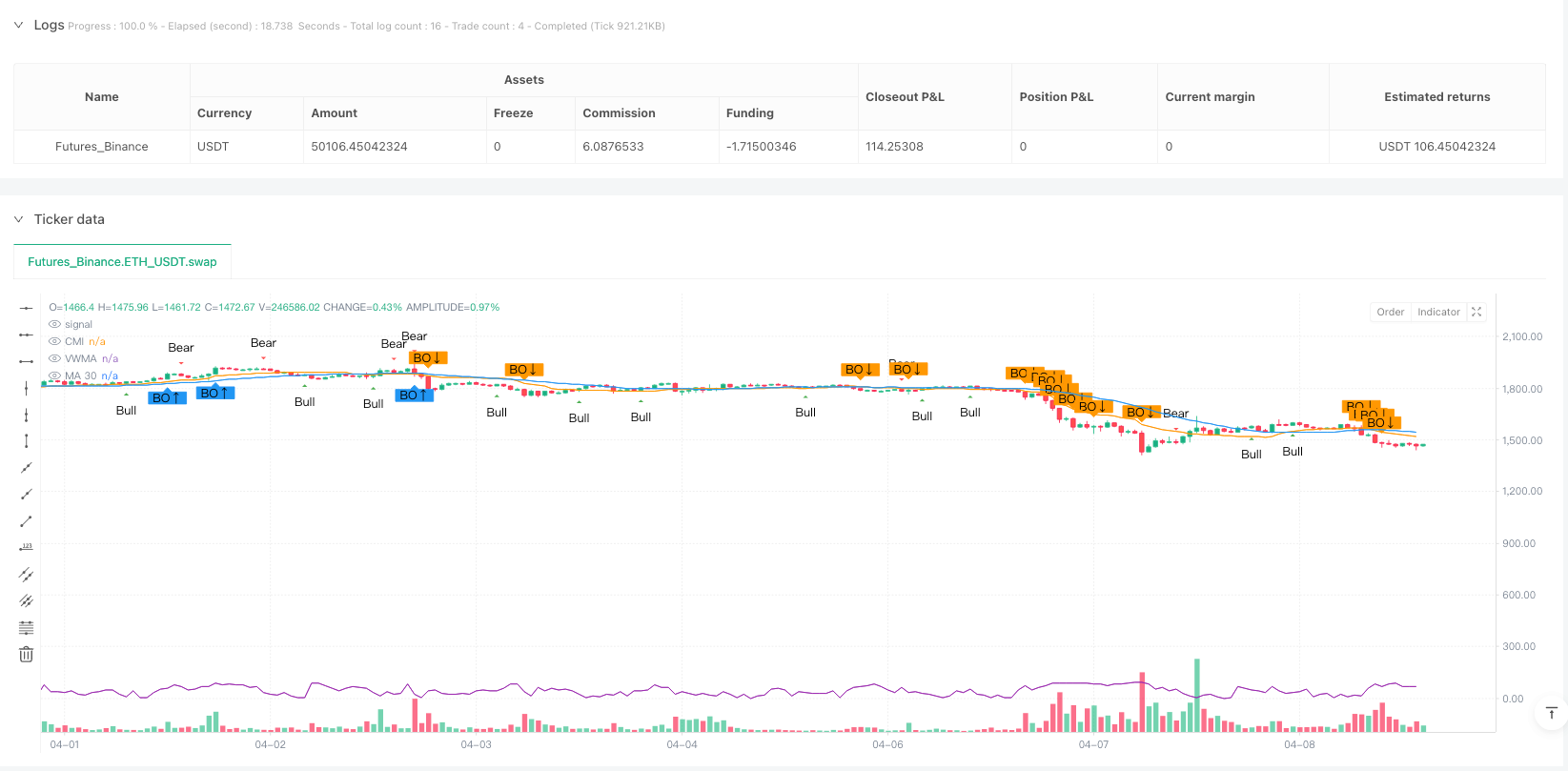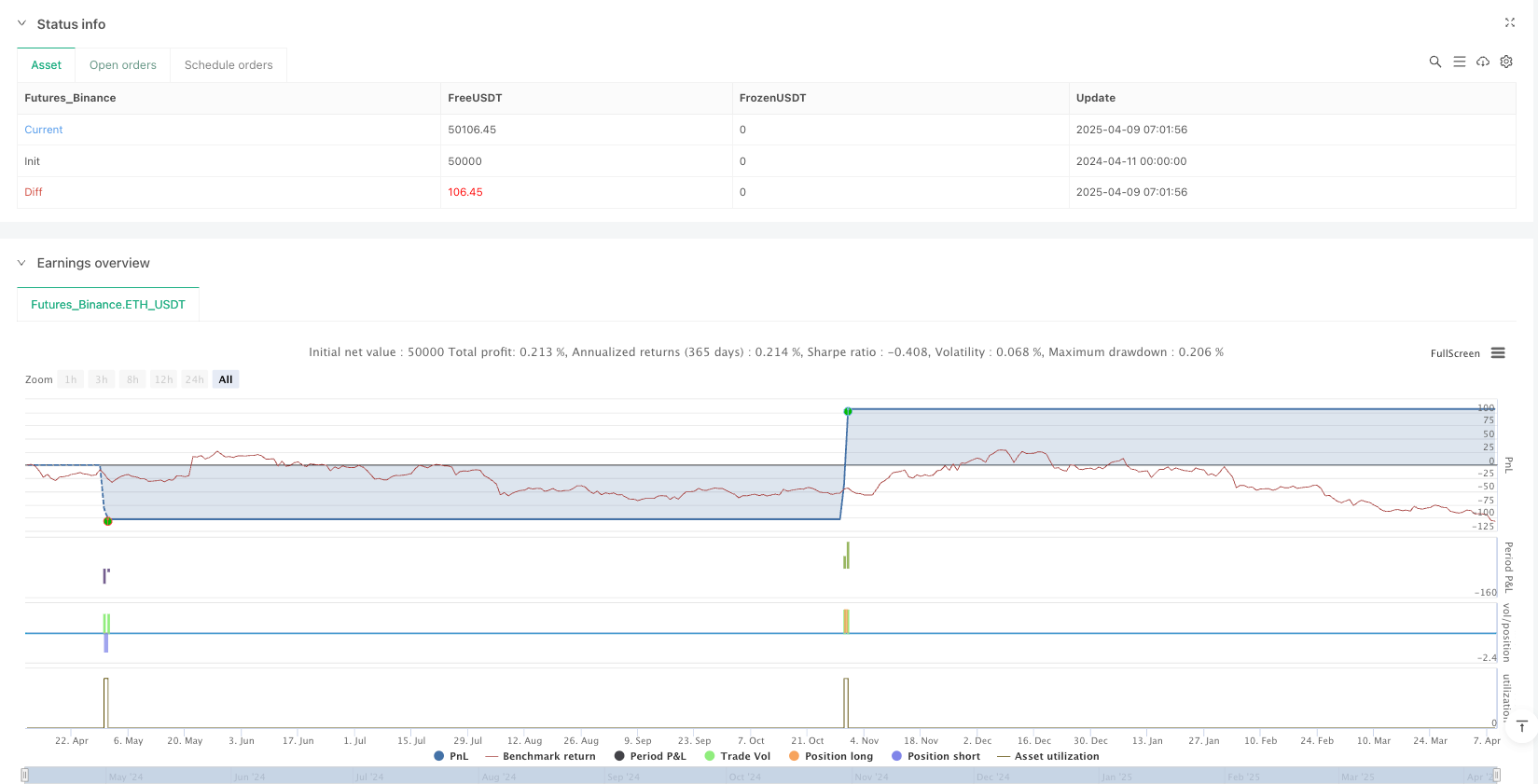

概述
该策略是一个综合性的交易系统,利用多时间框架分析、技术指标融合和形态识别来寻找高概率交易机会。其核心理念是通过分析五个不同时间框架(1分钟、5分钟、15分钟、1小时和4小时)的趋势一致性,结合成交量突破、吞没形态和动量指标,以精确捕捉市场动向。该策略同时内置自动止盈止损机制,根据市场波动性动态调整风险管理参数。
策略原理
策略核心基于以下几个关键组件:
多时间框架趋势分析:策略首先通过自定义函数
getTrend()分析5个不同时间框架的趋势。在每个时间框架上,系统检查快速EMA是否高于慢速EMA、RSI值是否超过50以及价格是否高于快速EMA来确定做多信号;相反条件则确定做空信号。趋势共识确认:只有当所有五个时间框架显示相同方向的趋势信号时,系统才会考虑入场。这种严格的趋势共识机制大大提高了信号的可靠性。
入场条件优化:除了趋势共识外,入场还需满足以下条件:
- 吞没形态(看涨或看跌)确认
- 成交量突破(高于20周期平均成交量的2倍)
- RSI确认(做多时>55,做空时<45)
- 狭义市场指数CMI>30(确保足够的市场动量)
- 价格相对于成交量加权移动平均线(VWMA)的位置确认
风险管理系统:策略采用动态止盈止损计算方法,基于最近价格波动(高低价差)设置止损水平,并使用倍数参数(默认为2.0)设置止盈目标。
支撑/阻力可视化:系统自动识别并显示重要的支撑和阻力位,通过视觉辅助帮助交易者理解当前市场结构。
策略优势
多维信号过滤:通过要求多个技术指标和时间框架的一致性,显著降低了虚假信号的可能性。这种多重确认机制使策略只在高概率设置下触发交易信号。
自适应风险管理:止损和止盈水平不是固定的,而是基于当前市场波动性动态计算的,这使策略能够在不同波动条件下保持适当的风险回报比。
完整的可视化系统:策略包含全面的视觉辅助工具,包括趋势仪表板、支撑/阻力框、交易信号标记和预测的止盈/止损线,为交易者提供直观的市场分析。
成交量确认:通过要求交易信号伴随显著的成交量增加,策略能够识别具有实际动力的市场移动,而不仅仅是价格的随机波动。
形态识别整合:吞没形态作为入场条件的一部分,增加了策略的准确性,因为这些蜡烛图形态通常代表市场情绪的显著转变。
策略风险
频繁再平衡需求:由于策略依赖于多个时间框架的一致性,交易信号可能相对罕见。在长时间没有交易机会的情况下,交易者可能被诱导降低标准,导致执行不理想的交易。
信号依赖性:策略严重依赖于技术指标和形态,在某些市场条件下,如突发新闻事件或极端波动期间,这些信号可能失效或提供误导性指示。
过度优化风险:策略使用多个参数和条件,这可能导致历史数据过度优化,而在真实市场条件下表现不佳。需要在足够长的时间框架和不同市场条件下进行彻底的回测。
计算复杂性:多时间框架分析和多重指标计算需要大量计算资源,这可能导致某些交易平台上的性能问题或延迟。
趋势转变检测延迟:由于策略需要多个时间框架的一致性,它可能在趋势转变的早期阶段错过机会,直到新趋势在所有时间框架上都已确立。
优化方向
自适应参数调整:引入机制使EMA长度、RSI阈值和CMI要求根据当前市场波动性或交易时段自动调整,以适应不同的市场状态。
时间框架权重系统:不是简单地要求所有时间框架一致,可以实施加权系统,其中较高时间框架的信号具有更大影响,这可能产生更及时的信号,同时保持高质量标准。
市场状态分类:添加算法来检测当前市场是处于趋势状态还是区间状态,并相应地调整策略参数。例如,在区间市场中可能需要更高的CMI阈值。
机器学习整合:使用机器学习算法优化入场和出场规则,基于历史数据识别最有效的信号组合,并随着新数据的积累不断改进。
增强多样化:添加其他无相关性的技术指标,如斐波纳契回撤水平、关键价格水平或市场情绪指标,以提供额外的确认维度。
总结
多时间框架融合型动量捕捉自动交易策略是一个全面的交易系统,通过严格的多重确认机制来识别高概率交易机会。通过结合趋势分析、成交量确认、形态识别和动态风险管理,该策略旨在提供高质量的交易信号,同时管理每笔交易的风险。
虽然该策略的严格条件可能导致交易信号相对较少,但这实际上是其主要优势之一,因为它优先考虑信号质量而非数量。通过建议的优化措施,特别是自适应参数和市场状态分类,策略可以进一步提高其性能和适应性。
对于追求系统化、纪律化交易方法的交易者,这种多层面分析和严格确认的方法提供了一个强大的框架,能够在不同市场环境中保持一致性,同时通过自动化规则减少情绪偏见的影响。
/*backtest
start: 2024-04-11 00:00:00
end: 2025-04-09 08:00:00
period: 1h
basePeriod: 1h
exchanges: [{"eid":"Futures_Binance","currency":"ETH_USDT"}]
*/
//@version=5
strategy("M.Shiham-XAUUSD Sniper Strategy", overlay=true, default_qty_type=strategy.percent_of_equity, default_qty_value=10, max_lines_count=500, max_boxes_count=500)
// === Input ===
fastLen = input.int(9, "Fast EMA")
slowLen = input.int(21, "Slow EMA")
rsiLen = input.int(14, "RSI Period")
tpMultiplier = input.float(2.0, "TP Multiplier")
slMultiplier = input.float(1.0, "SL Multiplier")
// === Function Trend Check ===
getTrend(tf) =>
emaFast = request.security(syminfo.tickerid, tf, ta.ema(close, fastLen))
emaSlow = request.security(syminfo.tickerid, tf, ta.ema(close, slowLen))
rsi = request.security(syminfo.tickerid, tf, ta.rsi(close, rsiLen))
price = request.security(syminfo.tickerid, tf, close)
isBuy = emaFast > emaSlow and rsi > 50 and price > emaFast
isSell = emaFast < emaSlow and rsi < 50 and price < emaFast
isBuy ? 1 : isSell ? -1 : 0
// === Trend by Timeframe ===
trend1m = getTrend("1")
trend5m = getTrend("5")
trend15m = getTrend("15")
trend1h = getTrend("60")
trend4h = getTrend("240")
// === Alert Conditions ===
allBuy = trend1m == 1 and trend5m == 1 and trend15m == 1 and trend1h == 1 and trend4h == 1
allSell = trend1m == -1 and trend5m == -1 and trend15m == -1 and trend1h == -1 and trend4h == -1
alertcondition(allBuy, title="All TF Buy", message="🔔 BUY SIGNAL! All timeframes agree: BUY XAUUSD")
alertcondition(allSell, title="All TF Sell", message="🔔 SELL SIGNAL! All timeframes agree: SELL XAUUSD")
txt(val) => val == 1 ? "BUY" : val == -1 ? "SELL" : "-"
clr(val) => val == 1 ? color.green : val == -1 ? color.red : color.gray
// === Table Dashboard (Optional Toggle) ===
showTable = input.bool(true, "Show Trend Dashboard")
var table t = table.new(position.top_right, 2, 6, border_width=1)
if showTable and bar_index % 5 == 0
table.cell(t, 0, 0, "Timeframe", text_color=color.white, bgcolor=color.black)
table.cell(t, 1, 0, "Signal", text_color=color.white, bgcolor=color.black)
table.cell(t, 0, 1, "1 MIN", text_color=color.white)
table.cell(t, 1, 1, txt(trend1m), bgcolor=clr(trend1m), text_color=color.white)
table.cell(t, 0, 2, "5 MIN", text_color=color.white)
table.cell(t, 1, 2, txt(trend5m), bgcolor=clr(trend5m), text_color=color.white)
table.cell(t, 0, 3, "15 MIN", text_color=color.white)
table.cell(t, 1, 3, txt(trend15m), bgcolor=clr(trend15m), text_color=color.white)
table.cell(t, 0, 4, "1 H", text_color=color.white)
table.cell(t, 1, 4, txt(trend1h), bgcolor=clr(trend1h), text_color=color.white)
table.cell(t, 0, 5, "4 H", text_color=color.white)
table.cell(t, 1, 5, txt(trend4h), bgcolor=clr(trend4h), text_color=color.white)
// === Support/Resistance Box ===
pHigh = ta.pivothigh(high, 5, 5)
pLow = ta.pivotlow(low, 5, 5)
// === Volume Spike ===
avgVol = ta.sma(volume, 20)
volSpike = volume > avgVol * 2
// === Breakout + Alert ===
breakoutUp = high > ta.highest(high, 20)[1] and volSpike
alertcondition(breakoutUp, title="Breakout Up", message="🚀 XAUUSD Breakout Up with Volume")
breakoutDown = low < ta.lowest(low, 20)[1] and volSpike
alertcondition(breakoutDown, title="Breakout Down", message="⚠️ XAUUSD Breakout Down with Volume")
// === Engulfing Pattern ===
bullishEngulf = open[1] > close[1] and close > open and open < close[1] and close > open[1]
bearishEngulf = open[1] < close[1] and close < open and open > close[1] and close < open[1]
// === Moving Averages, Momentum & RSI ===
rsi = ta.rsi(close, rsiLen)
cmiPeriod = 14
cmi = 100 * math.abs(close - close[cmiPeriod]) / (ta.highest(high, cmiPeriod) - ta.lowest(low, cmiPeriod))
vwma = ta.vwma(close, 20)
plot(cmi, title="CMI", color=color.purple, display=display.none)
plot(vwma, title="VWMA", color=color.orange, display=display.none)
ma30 = ta.sma(close, 30)
plot(ma30, title="MA 30", color=color.blue)
// === STRATEGY MODE: Auto Entry & TP/SL ===
longEntry = allBuy and bullishEngulf and volSpike and rsi > 55 and cmi > 30 and close > vwma
shortEntry = allSell and bearishEngulf and volSpike and rsi < 45 and cmi > 30 and close < vwma
if (longEntry)
strategy.entry("Buy", strategy.long)
entry = close
sl = entry - (high - low) * slMultiplier
tp = entry + (entry - sl) * tpMultiplier
strategy.exit("TP Buy", from_entry="Buy", stop=sl, limit=tp)
if (shortEntry)
strategy.entry("Sell", strategy.short)
entry = close
sl = entry + (high - low) * slMultiplier
tp = entry - (sl - entry) * tpMultiplier
strategy.exit("TP Sell", from_entry="Sell", stop=sl, limit=tp)
if longEntry
entry = close
sl = entry - (high - low) * slMultiplier
tp = entry + (entry - sl) * tpMultiplier
if shortEntry
entry = close
sl = entry + (high - low) * slMultiplier
tp = entry - (sl - entry) * tpMultiplier
// === Plot Signals ===
plotshape(bullishEngulf, title="Bullish Engulfing", location=location.belowbar, color=color.green, style=shape.triangleup, size=size.small, text="Bull")
plotshape(bearishEngulf, title="Bearish Engulfing", location=location.abovebar, color=color.red, style=shape.triangledown, size=size.small, text="Bear")
plotshape(breakoutUp, title="Breakout Up", location=location.belowbar, color=color.blue, style=shape.labelup, text="BO↑")
plotshape(breakoutDown, title="Breakout Down", location=location.abovebar, color=color.orange, style=shape.labeldown, text="BO↓")